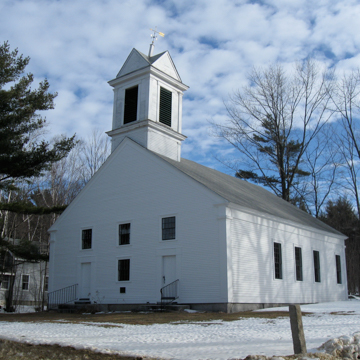Located at the original town center, the first Freewill Baptist Church is a compelling, well-preserved example of a typical early- to mid-nineteenth-century New Hampshire rural ecclesiastical structure. Following the tenets of the traditional rectangular, pitched-roof building form, the church embodies in wood materials principles of Greek Revival–style embellishment. The three-bay, southeast-facing gable facade is bounded by the flat Doric corner pilasters capped by partial entablatures and abbreviated returns of the open gable pediment. Set in the facade are two four-panel doors flanked by thick, flat molding strips and topped by thick architraves with corner blocks. Dominating the building on the roof ridge above the gable facade is a somewhat ponderous, nonetheless imposing belfry containing the original church bell. Set on a square base with corner pilasters supporting an entablature, the belfry is square in plan and also displays corner pilasters and an entablature. It is furnished with louvered apertures on each side and is protected by a cross-gable roof with a metal weathervane. The interior four-aisle auditorium, slightly remodeled c. 1848, is simply adorned, and features a rear cantilevered gallery illuminated by three second-story windows on the gable facade. Since at least 1885, the building has been maintained by non-denominational efforts, particularly those of the East Alton Community Association organized in the late 1920s.
You are here
First Freewill Baptist Church
If SAH Archipedia has been useful to you, please consider supporting it.
SAH Archipedia tells the story of the United States through its buildings, landscapes, and cities. This freely available resource empowers the public with authoritative knowledge that deepens their understanding and appreciation of the built environment. But the Society of Architectural Historians, which created SAH Archipedia with University of Virginia Press, needs your support to maintain the high-caliber research, writing, photography, cartography, editing, design, and programming that make SAH Archipedia a trusted online resource available to all who value the history of place, heritage tourism, and learning.

